Category: Geek
I am extremely pleased with the way DemoCamp 17 went. We had some great demos and Ignite presentations at the Toronto Board of Trade dining room, followed by one of the best post-DemoCamp after-parties at the Duke of Westminster. My thanks to all the attendees, the presenters, Jay Goldman for doing a lot of the heavy lifting and the very kind folks at the Toronto Board of Trade.
Pema Hegan of GigPark sent me a scan from today’s National Post, which appears below:
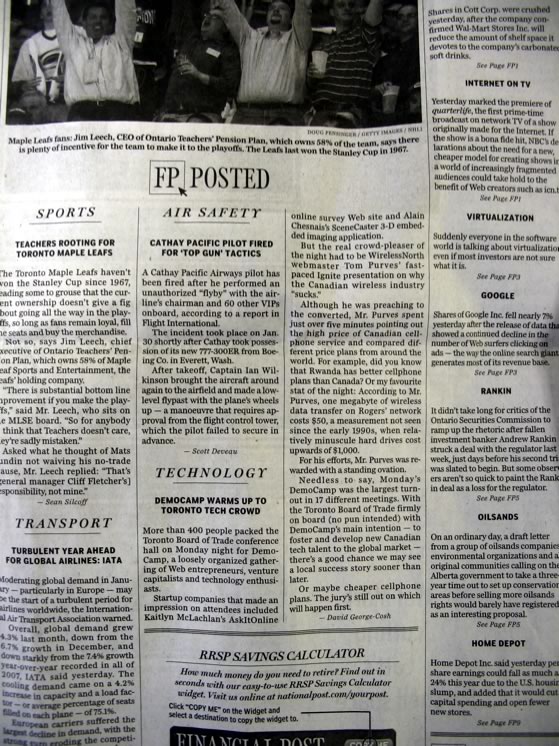
I transcribed the article about DemoCamp:
DemoCamp Warms Up to Toronto Tech Crowd
More than 400 people packed the Toronto Board of Trade conference hall on Monday night for DemoCamp, a loosely organized gathering of Web entrepreneurs, venture capitalists and technology enthusiasts.
Startup companies that made an impression on attendees included Kaitlyn McLachlan’s AskItOnline online survey Web site and Alain Chesnais’s SceneCaster 3-D embedded imaging application.
But the real crowd-pleaser of the night had to be WirelessNorth webmaster Tom Purves’ fast-paced Ignite presentation on why the Canadian wireless industry “sucks.”
Although he was preaching to the converted, Mr. Purves spent just over five minutes pointing out the high price of Canadian cellphone service and compared different price plans from around the world. For example, did you know that Rwanda has better cellphone plans than Canada? Or my favourite stat of the night: According to Mr. Purves, one megabyte of wireless data transfer on Rogers’ network costs $50, a measurement not seen since the early 1990s, when relatively minuscule hard drives cost upward of $1000.
For his efforts, Mr. Purves was rewarded with a standing ovation.
Needless to say, Monday’s DemoCamp was the largest turnout in 17 different meetings. With the Toronto Board of Trade firmly on board (no pun intended) with DemoCamp’s main intention — to foster and develop new Canadian tech talent to the global market — there’s a good chance we may see a local success story sooner than later.
Or maybe cheaper cellphone plans. The jury’s still out on which will happen first.
David George-Cosh
ICT Toronto is a City Hall initiative whose goals are, in their own words, to make Toronto a place that “will become, and be acknowledged globally, as one of the 5 most innovative, creative and productive locations in the world for ICT research, education, business, and investment by 2011”. They’ll be lucky if they manage to update their useless website — a single-pager with very little information and unchanged since April 2006 — by 2011.
Their focus thus far has been attracting high-tech multinationals to build branch offices here and make us a place to “nearsource”. As far as the local tech community goes, ICT Toronto sees the local tech and startup community in the same way Grandma sees the TV remote:

(I use the same comic for a slightly different purpose over at this article in Global Nerdy.)
A couple of articles have already appeared in response to Ideas to Steal from Silicon Valley and Seattle:
Chris Ragobeer: An Open Letter to Toronto’s Technology Community
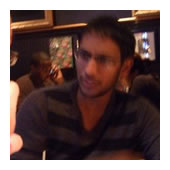 Over at The Toronto Marketing and Technology Blog, Chris Ragobeer wrote an article titled An Open Letter to Toronto’s Technology Community. In the article, Chris lists these things:
Over at The Toronto Marketing and Technology Blog, Chris Ragobeer wrote an article titled An Open Letter to Toronto’s Technology Community. In the article, Chris lists these things:
- Things that Toronto already has that will help in turning the city into a high-tech hub.
- Things Toronto needs to establish or acquire in order to turn the city into a high-tech hub.
- Some suggested actions that the local high-tech community can take.
David Crow: Harnessing Hogtown’s Hominids for High-Tech Hijinks and Hubs
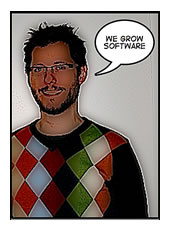 David Crow (who recently was voted Toronto’s best tech evangelist at BlogTO, running against some pretty stiff competition including Yours Truly) also responded to my article in a piece with an extremely alliterative title: Harnessing Hogtown’s Hominids for High-Tech Hijinks and Hubs. In the article, he makes these points:
David Crow (who recently was voted Toronto’s best tech evangelist at BlogTO, running against some pretty stiff competition including Yours Truly) also responded to my article in a piece with an extremely alliterative title: Harnessing Hogtown’s Hominids for High-Tech Hijinks and Hubs. In the article, he makes these points:
- Where is our “Fairchild” that creates our own “Fairchildren”? “Can you name big successful software companies that have started in Toronto? More importantly, can you name successful companies that have started because the founders were members of another “parent” company? Why has RIM or Nortel not created a strong spinoff culture?”
- One possible source of “Fairchildren” might be people who’ve spent time in Silicon Valley and other hubs, who’ve either returned or migrated to Toronto to start companies here. They bring with them experience and connections and “might be a better hope for new wealth creation in Toronto in the high-tech sector.”
- ICT Toronto is a joke. David’s feeling about City Hall’s attempt to bolster Toronto’s standing as a high-tech hub is similar to mine: “We have a fascination with self-congratulatory bullshit efforts!” Last year’s TechWeek was a non-event that registered on almost nobody’s radar, and I have my doubts about this year’s. Their goals are misguided, and they have no idea of what it means to be local technology company. They seem to be focused on on turning Toronto into a place to do “nearsourcing”, in which case they might as well come up with a marketing campaign like “Toronto: The Bangalore Next Door” and resign us to the fate of being a call center hub.
[This article was also posted on Global Nerdy.]
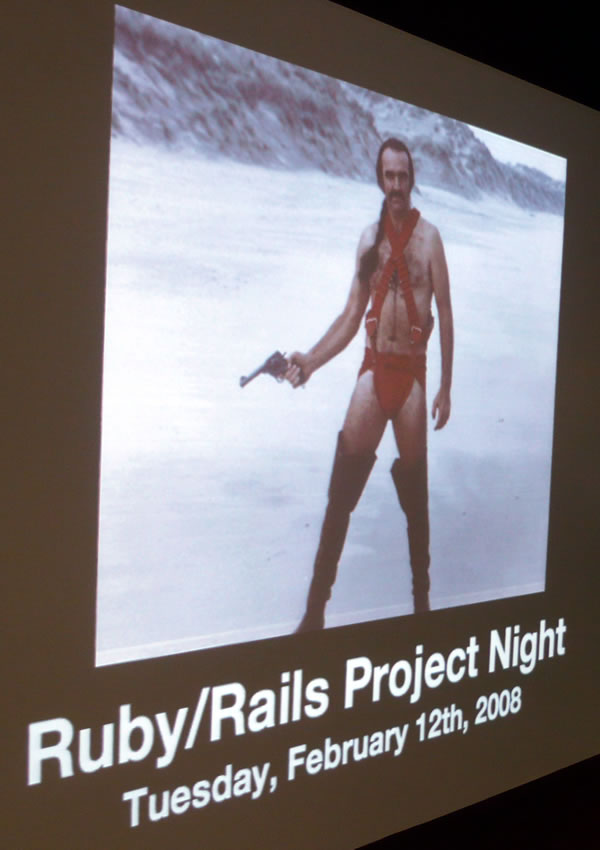
Sean Connery’s character, “Zed” from the movie Zardoz has become the unofficial mascot of my Project Night opening monologues.
In spite of yesterday’s all-day snowstorm and sub-freezing temperatures (-10 C / 14 F), about a couple of dozen people still showed up for last night’s Ruby/Rails Project Night, TSOT’s monthly session where developers from Toronto and surrounding areas get together to see in-depth presentations on projects done using Ruby and Rails.

One of the slides from my opening monologue.
As per tradition (well, as much tradition as you can get with this being only the second Project Night), I presented the opening monologue, titled Do the Stupidest Thing That Could Possibly Work. The basic premise: if a stupid idea works for you, it isn’t stupid. It’s something I’d been meaning to do — a live version of this article from last June.

The first presenter was Rowan Hick, with his presentation How to Avoid Hanging Yourself in Rails, a guide to getting the most out of ActiveRecord. He billed it as something intended for developers new to Rails or intermediate developers who’ve been frustrated by Rails’ database performance.
A good chunk of his presentation focused on ways of speeding up getting results from ActiveRecord, which can summarized in a chart like this:
| Method | Requests per second | Speed index | Notes |
|---|---|---|---|
find(:all) |
5.26 | 1x (baseline) | Straight out of every Rails tutorial every written. |
find(:all, :include) |
7.70 | 1.4x | A little better… |
find(:all, :select, :include) |
15.15 | 2.88x | Nearly 3 times the speed for only a little work. |
find_by_sql |
28.90 | 5.49x | Considerably faster, but no longer database-independent and harder to maintain. Still, I can see optimizations like this in my future… |
| Merb | 38.56 | 7x | Next to Rails, Merb is blazingly fast, and Rowan says you can use code nearly identical to Rails. I’ll have to give it a peek sometime… |
Rowan is kindly sharing the slides from his presentation — you can get it from this entry in his blog.
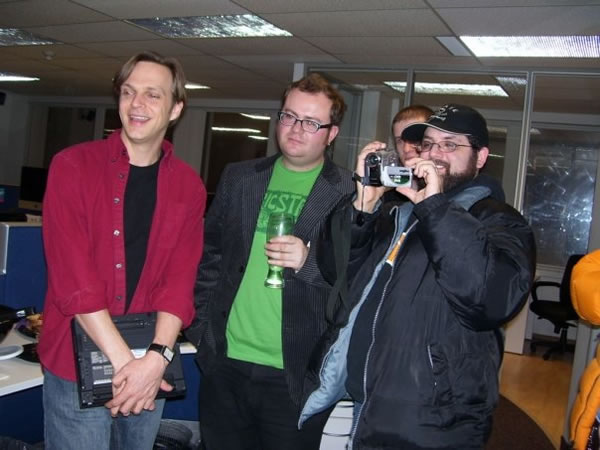
Andrew, Pete and Krispy were among those who braved the snow to attend. Thanks for coming out, guys!
Photo courtesy of Mike Bowler.
Next came Mike Bowler, who presented Easy Branding Tools, his one-stop online shop for ordering all sorts of things related to your brand — from business cards and stationery to domain names — powered mostly by Rails. Notable points in his presentation included:
- “PassiveRecord”, which was his way of creating subclasses of ActiveRecord for objects that weren’t connected to the database but still had ActiveRecord goodies like validation.
- Some custom validations
- Thoughts on running tasks in the background: he used
script/runnerfor this project, but for future apps, he’s more likely to usebackgroundrb.

The final presentation was Luke Galea’s who presented CRMS: Clinical Research Management System, an enterprise-class Rails app that manages drug and treatment experimental trials carried out at various hospitals across the United States.he covered all sorts of aspects of building such an app, which included using databases not typically used with Rails (the hospitals tend to use SQL Server), offloading some work to apps implemented in other languages (some hairy calculations are handed off to an engine written in Prolog), and building a “vanilla” app with features needed by all the research hospitals, and “spicing” them individually as needed by each client.
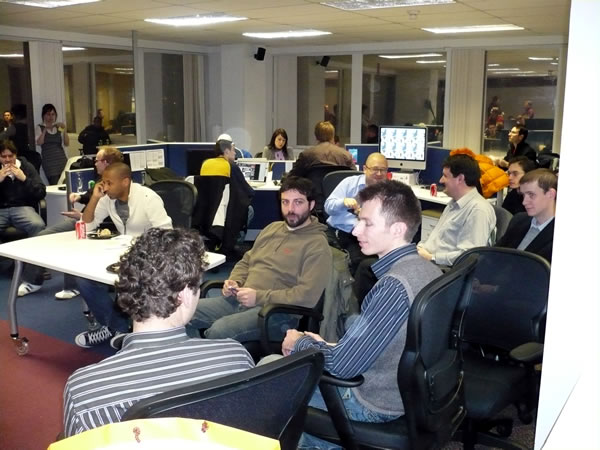
We kept things moving quickly so that people could brave the snow and go home, so the event wrapped up at 8:00 p.m.. More than a few decided to join us at the TSOT development team’s semi-official watering hole, Hemingway’s, to hoist some pints and socialize.
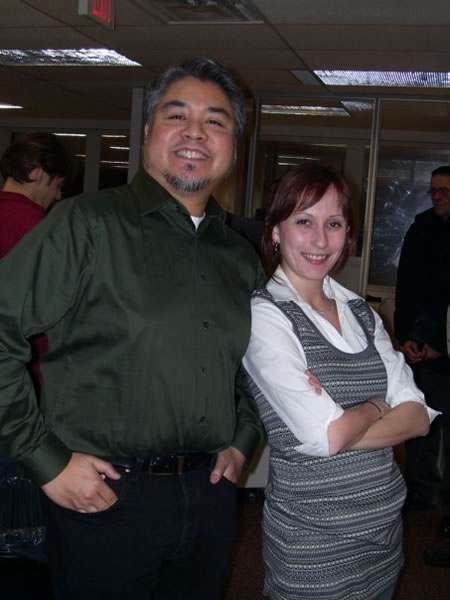
Joey deVilla and Corina Newby.
I’d like to thanks the presenters for the work they put into their presentations and the attendees for braving the snow and coming out! I’d also like to say thanks to my co-worker and TSOT’s VP of Public Relations, Corina Newby, for doing the heavy lifting in getting the event together.
If you’ve got a Ruby or Rails project that you’d like to show off in front of your peers in a 20- to 30-minute presentation (where you can get as in-depth and tech-y as you like), we’d like you to present! Email either Corina or me for details.
Keep an eye open for announcement of the next Ruby/Rails Project Night!
Here’s a photo to remind you that TSOT’s Second Ruby/Rails Project Night is just over a day away:
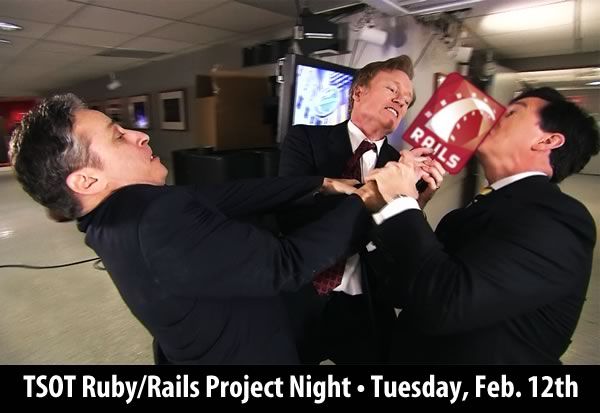
For more details about Ruby/Rails project night, see this blog entry.
Here’s a photo to remind you that DemoCamp 17 — the “show and tell” gathering of the bright lights of Toronto’s tech community — is just over a week away:

For more details about DemoCamp 17, see:
